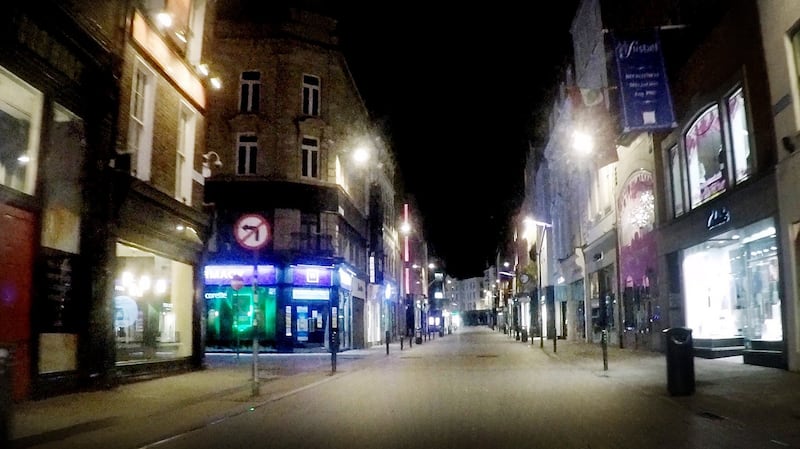Shortly before 9pm on any given Friday night and Dublin’s city centre is normally teeming with life as happy people spill out of shops and into pubs to meet merrier ones who had gone straight from work for a quick one that turned into several slow ones.
The heady cocktail of locals in locals is normally infused with a healthy splash of tourists and people who have gone home to get ready before coming back into the city centre raring to go out-out.
But on the first Friday of April 2020, the first Friday since Ireland went into almost complete lockdown in an attempt to slow the spread of coronavirus, the city was a ghost town.
It has changed utterly. And there is no beauty in it. It is simply terrible.
Over the course of an hour starting at 8.30pm, The Irish Times travelled the city to gauge how it has changed in recent weeks.
It has changed utterly. And there is no beauty in it. It is simply terrible.
The route went from Camden St south of the river to the heart of the northside on Parnell Square. It went up and down the quays and through some of the tourist hot spots. With each corner turned the journey grew increasingly surreal.
On any given Friday, the taxis on Camden St are bumper to bumper as are the pubs. They are absolutely jammers. But on this Friday night the street was stripped of all that makes it special. There were hardly any cabs to be seen. And there was even fewer people seeking to flag them down.
The only life on the street centred around a handful of takeaway restaurants where delivery people on bikes with hotboxes on their backs geared themselves up to provide an “essential service” to some of the city’s hungry.
It was bleaker still on Harcourt St, home to Copper Face Jacks and Dicey Reily's and all the other booze-filled party spots that would normally draw people by their thousands on a weekend night like this.
A gang of six or seven teenagers, ignoring or ignorant of the strict social distancing rules in place across the country looked equal parts bored and menacing as they loitered on O'Connell St.
Not tonight. Tonight the street was empty.
Everywhere was empty.
Or almost everywhere. A gang of six or seven teenagers, ignoring or ignorant of the strict social distancing rules in place across the country looked equal parts bored and menacing as they loitered on O’Connell St. A similarly sized group of teenage boys on pushbikes circled a small street off Camden St and looked equally intimidating. If anything they looked more so.
Save for a couple of buses ferrying no one from A to B there was nothing to see on College Green either and just one person was out and about on the part of the journey which stretched the whole length of Grafton St, that famous street where old ghosts meet.
The old ghosts had it to themselves save for that one soul walking disconsolately past all the high end designer shops with a grey hoodie pulled closed against the cold.
Another of the city's party hubs on South William St was dead save for some guards on bikes, crossing the city to make sure no one was up to mischief.
They were not the only ones on duty. Gardaí were a significant presence throughout the city and over the course of a two or three kilometre journey - from south to north and then back again The Irish Times met three checkpoints. There was one at the Ha’penny Bridge and another across the river on Bachelor’s Walk. There was a third checkpoint on O’Connell Bridge.

Temple Bar is Dublin's big draw after dark - at least for the thousands of tourists that would normally be visiting the city in April. But on this Friday night, it was dark and silent, save for the ubiquitous cycle couriers waiting outside a small handful of restaurants for takeaway food. Pubs were boarded up as if readying themselves for a ferocious storm.
In a way that is exactly what they were doing.
Back on the quays and on O’Connell St, public transport was still running, largely without anyone on it.
A Luas trundled down the country’s main thoroughfare carrying just a driver and one single passenger. On any other Friday the tram would have been full of people heading home and going out.
But there’s none of that now. There is nowhere to go but home and there won’t be for a while yet.









